- Books Name
- Social Science Book
- Publication
- Cognizance Publication
- Course
- CBSE Class 7
- Subject
- Social Science
Chapter 2
Inside Our Earth
The Earth is a dynamic planet. It is constantly undergoing changes inside and outside.2 months leave is not about spherical in shape.
Interior of the earth

Just like an onion, the earth is made up of several concentric layers, with one inside another.The uppermost layer over the earth surface is called the crust.It is the thinnest of all the layers.It is about 35 km thick on the land mass and only 5 km, on the ocean floors.The main mineral constituents of the continental mass are silica and alumina.It is the thus called ‘sial’(si-silica and al-alumina).The oceanic crust mainly consists of silicon and magnesium; It is therefore called ‘sima’(si-silica and ma- magnesium).
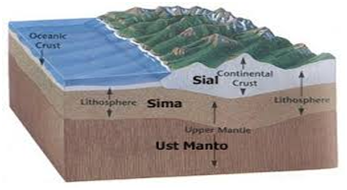
Mantle
Just beneath the crust is the mantle which extends upto a depth of 2900 km, below the crust.
Core
The inner most layer is the core with a radius of about 3500 km.It is mainly made up of nickel and iron, thus it is called ‘nife’(ni-nickel and fe-ferrous ieiron).The central core has very high temperature and pressure. The crust forms only 1% of the volume of the earth.84% consists of the mantle and 15% makes the core. The radius of the earth is 6371 km.The deepest mine in the world, is in South Africa. It is about 4km deep. In search of oil engineers have dug a hole about 6km deep. To reach to the centre of the earth we have to dig a hole 6000km, deep on the ocean floor.
Rocks and Minerals
Rocks
The earth’s crust is made up of various types of rocks.Any natural mass of mineral matter that makes up the earth's crust is called a rock. Rocks can be of different colour, size and texture.There are 3 major types of rocks.
[1] Igneous rocks.
[2] Sedimentary rocks.
[3] Metamorphic rocks.
Igneous rocks
When the molten magma cools, it became solid, and are called igneous rocks.They are also called primary rocks.The 2 types of igneous rocks are intrusive rocks and extrusive rocks.When the molten lava comes on the earth surface, it rapidly cools down and becomes solid on the crust. These rocks are called extrusive igneous rocks.They have a very fine grain structure, for example basalt.The Deccan Plateau is made up of basalt rocks.
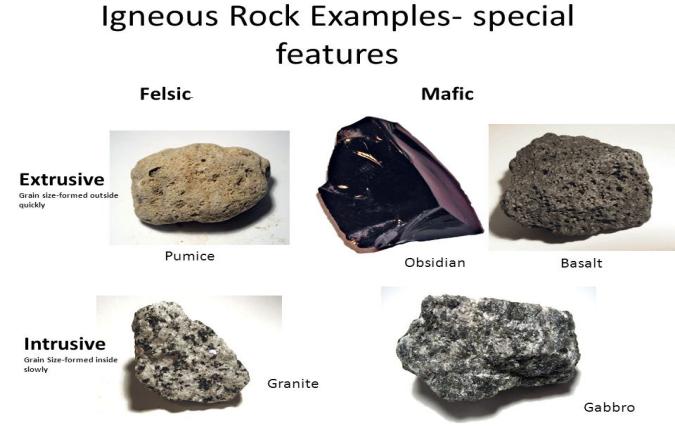
When the molten magma cools down deep inside the earth's crust giving formation of solid rocks are called intrusive igneous rocks.Since they cool down slowly, they forms large grains. Granite is example of such a rock.Grinding stones used to prepare paste.Powder of spices in grains are made of granite.
Sedimentary rocks
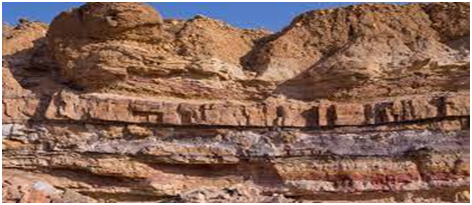
Rocks roll down, crack, and hit each other and are broken down into small fragments, which are called sediments. These sediments are transported and deposited by wind, water etc.These loose sediments are compressed and hardened to form layers of rocks. These types of rocks are called sedimentary rocks. For example,sandstone is made from grains of sand.These rocks may also contain fossils of plants, animals and other microorganisms that ones lived on them.
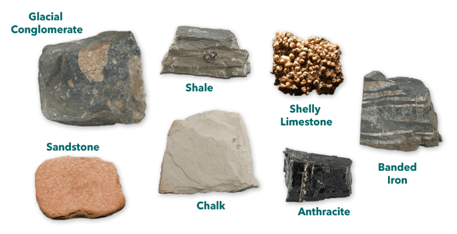
Metamorphic rocks
Under great heat and pressure, Igneous and sedimentary rocks can change into metamorphic rocks; example: clay changes into slate limestone into marble.
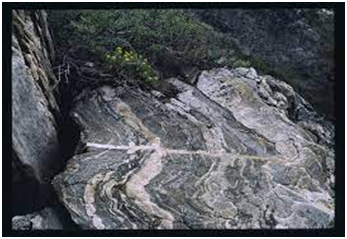
Igneous originated from latin word Ignis means fire. Sedimentary originated from latin word sedimentum meaning settle down. Metamorphic originated from greek word metamorphose meaning change of form.
Use of rocks
Rocks are very useful to us. The hard rocks are used for making roads, houses and buildings.Stones are used in many games;example:seven stones(pithoo), hopscotch (stapu/kit kit),five stones(gitti).They are source of mineral, which are useful for various purposes in daily life.
Rock cycle
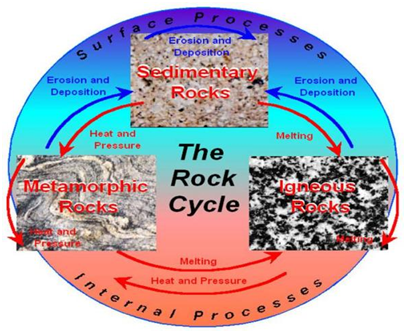
The process of transformation of the rock from one to another is called as the rock cycle.It describes the changes among the three main types of rocks that is igneous, sedimentary, and metamorphic rocks.When the molten magma cools, it solidifies to become igneous rocks.These igneous rocks are broken down into small particles by various agents such as weathering, temperature, wind etcand are transported and deposited to form sedimentary rocks.These similar grains of rocks keep moving towards basin and lower regions and gradually form sedimentary rocks.When the igneous and sedimentary rocks are subjected to heat and pressure, they change into metamorphic rocks.The metamorphic rocks, which are still under great heat and pressure meltdown to form molten magma.This molten magma again cool down and solidifying into igneous rocks.These processes take hundreds and thousands of years.
Fossils: The remains of the dead plants and animals trapped in the layers of rocks are called fossils.

 Cognizance Publication
Cognizance Publication
